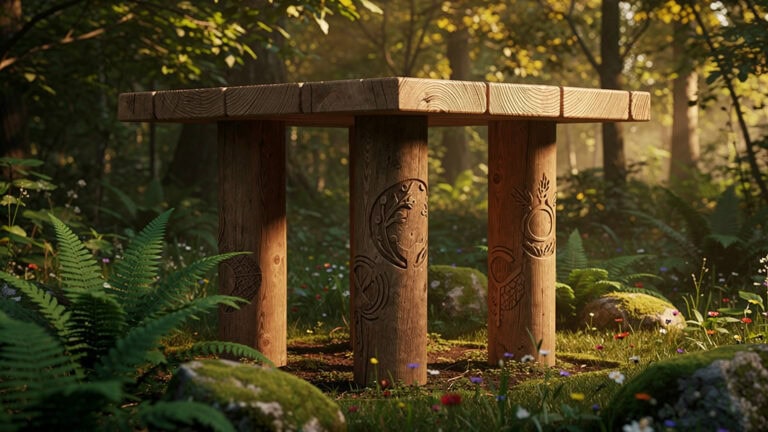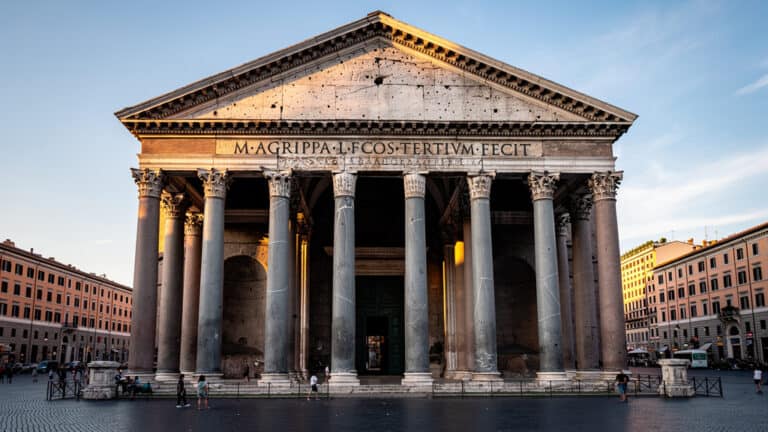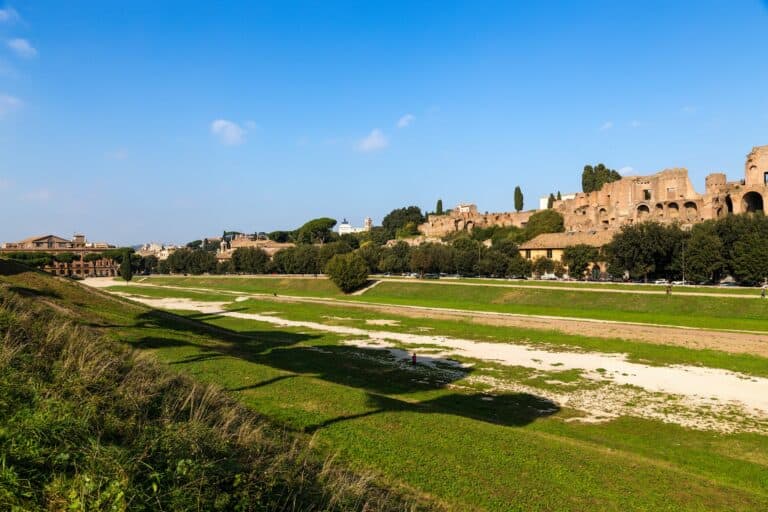Golf Cart Tours Rome – The Roman Empire is renowned for its incredible feats of engineering that laid the groundwork for modern infrastructure. From aqueducts to monumental buildings, their innovative techniques not only solved problems of their time but also influenced future generations. Here, we explore ten remarkable Roman engineering tricks, enriched with fascinating details, that continue to amaze us today.
10 Brilliant Innovations in Roman Engineering
The Roman Empire is celebrated not only for its vast territories and military prowess but also for its remarkable engineering achievements. From the iconic aqueducts that transported water across great distances to the intricate road systems that connected the empire, Roman engineers showcased ingenuity and innovation that laid the groundwork for modern infrastructure. In this article, we’ll explore ten brilliant innovations in Roman engineering that highlight their exceptional skills and enduring influence on contemporary architecture and construction practices. let’s find out
1. The Aqueducts: Bringing Water to the City
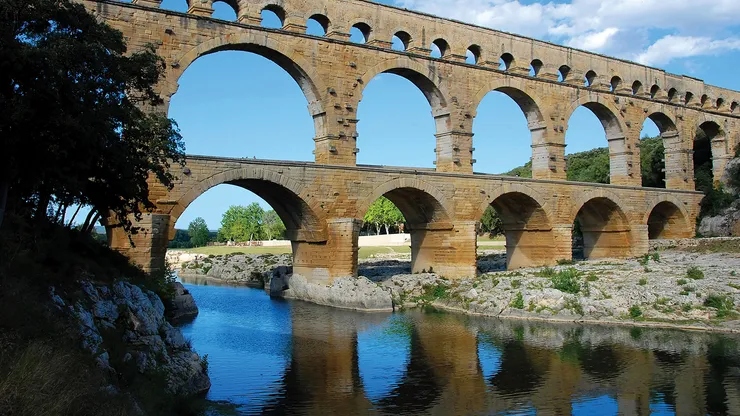
The Roman aqueduct system stands as one of the most impressive feats of engineering from the ancient world. These aqueducts carried fresh water from springs and rivers far outside city boundaries directly into urban centers, supplying fountains, public baths, households, and even lavish gardens. What made these aqueducts remarkable was their use of gravity alone to move water over immense distances, including through valleys, mountains, and challenging terrains.
The Aqua Appia, built in 312 BC, marked the beginning of this engineering revolution. Rome’s first aqueduct, the Aqua Appia was modest in size compared to later constructions, but it set the standard for a system that would become essential to Roman life. Over the next several centuries, engineers built longer and more complex aqueducts, including the Aqua Marcia, which spanned over 56 miles, and the towering Aqua Claudia, whose elevated arches became iconic symbols of Roman infrastructure.
Hidden Gem: Many aqueducts utilized a slight gradient, just enough to maintain flow without causing erosion. Some sections were built underground to protect the water from contamination and evaporation.
Why It’s Ingenious: The aqueducts not only ensured a reliable water supply for drinking and bathing but also supported public fountains, baths, and even irrigation for agriculture. This engineering marvel allowed cities to flourish and highlighted the Romans’ sophisticated understanding of hydraulics.
Explore the remnants of these incredible structures on an Etuk tour, where you’ll learn about their construction and see them up close. Book your Rome tour now!
2. Concrete Revolution
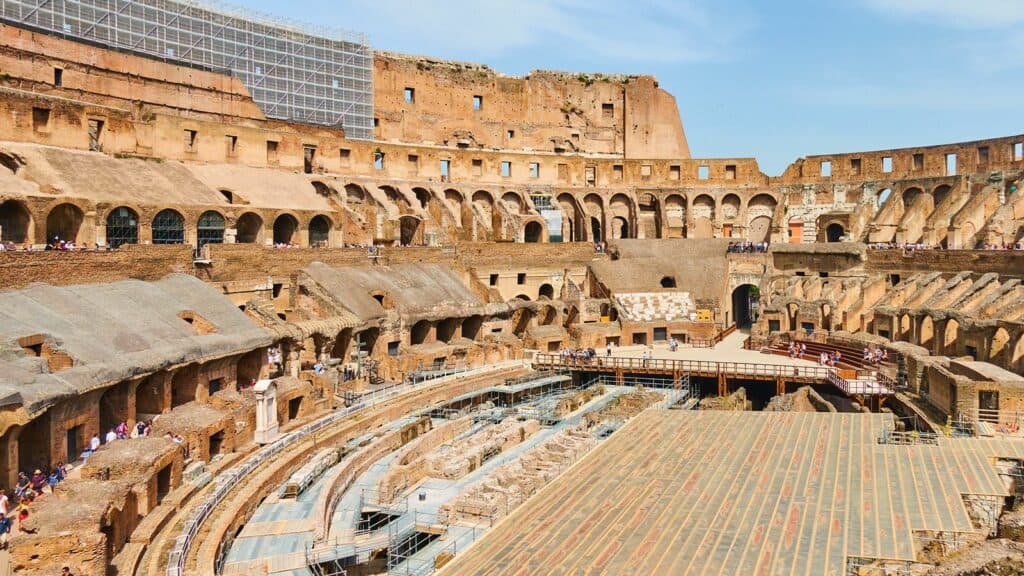
architecture and engineering. Unlike modern concrete, Roman concrete was made by mixing volcanic ash, lime, and seawater, producing a strong, durable material that could even set underwater. This unique blend, known as opus caementicium, was resistant to cracking and degradation, enabling the construction of massive, enduring structures that have withstood the test of time.
This innovative material allowed the Romans to break free from traditional building limitations. One of the most remarkable achievements made possible by Roman concrete is the Pantheon in Rome, which still holds the record for the largest unreinforced concrete dome in the world. Its dome, spanning 142 feet, remains an architectural marvel, illustrating the strength and adaptability of Roman concrete. By incorporating lightweight pumice near the dome’s apex and using heavier materials at the base, the Romans ingeniously managed weight distribution, ensuring the dome’s longevity without reinforcement.
Hidden Gem: The specific volcanic ash used in their concrete, called pozzolana, not only improved strength but also allowed the material to withstand the test of time. The exact formula for Roman concrete was lost for centuries and is only now being rediscovered.
Why It’s Ingenious: The versatility of concrete enabled the Romans to create complex shapes and structures, pushing the boundaries of architectural design. Their techniques have influenced modern construction practices and materials.
When in Rome, explore these monumental buildings on our guided tours and understand the genius behind their design. Experience the resilience of Roman engineering firsthand!
3. Arch and Vault Construction
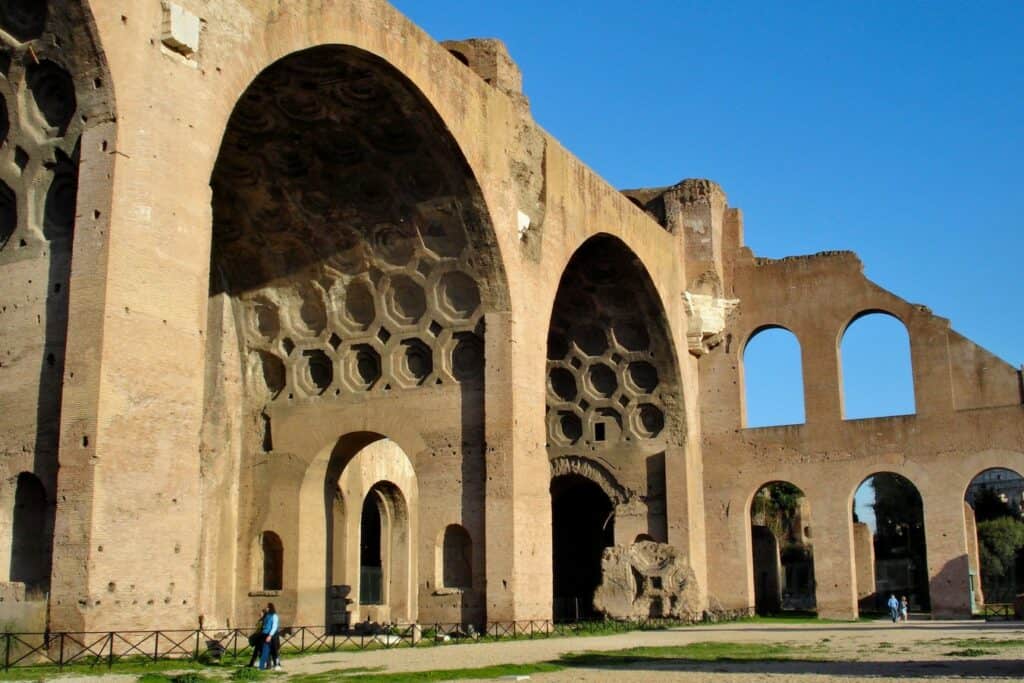
The Romans mastered the art of building with arches and vaults, a breakthrough that enabled them to construct larger, more stable, and enduring structures than ever before. By perfecting the semi-circular arch, Roman engineers discovered they could channel the weight of massive buildings outward rather than downward, allowing for the construction of spacious interiors, grand facades, and soaring ceilings. This innovation paved the way for monumental architecture and infrastructure, from temples and amphitheaters to aqueducts and public buildings.
One of the most iconic examples of Roman ingenuity with arches is the triumphal arch. Built to celebrate military victories and honor emperors, triumphal arches became grand entrances that symbolized Rome’s power and glory. The Arch of Constantine, constructed in 315 AD near the Colosseum, is a stunning testament to this technique. Standing nearly 70 feet tall, it features intricately carved reliefs and statues, creating a lasting monument to Constantine’s victory at the Battle of Milvian Bridge.
The use of arches extended beyond mere decoration. By incorporating vaults—extended arches that form a roof or ceiling—the Romans could build expansive interiors without relying on numerous support columns, allowing for open, uninterrupted spaces within structures like basilicas and bath complexes. These advancements revolutionized Roman architecture and influenced building techniques for centuries, forming the basis of many modern structural designs. Today, the legacy of Roman arches and vaults lives on, inspiring architects worldwide and showcasing the timeless nature of Roman engineering expertise.
Hidden Gem: The key to the strength of the arch lies in the keystone at the top; it locks the other stones into place, distributing weight evenly and allowing for the construction of larger spans.
Why It’s Ingenious: This method not only enhanced the aesthetic appeal of their buildings but also increased their stability and longevity. The principles behind arch construction are still fundamental in modern architecture and engineering.
Join an Etuk tour to walk through Rome’s historic arches and learn how they influenced Renaissance architects. Witness their beauty and engineering excellence!
4. Roads Built to Last
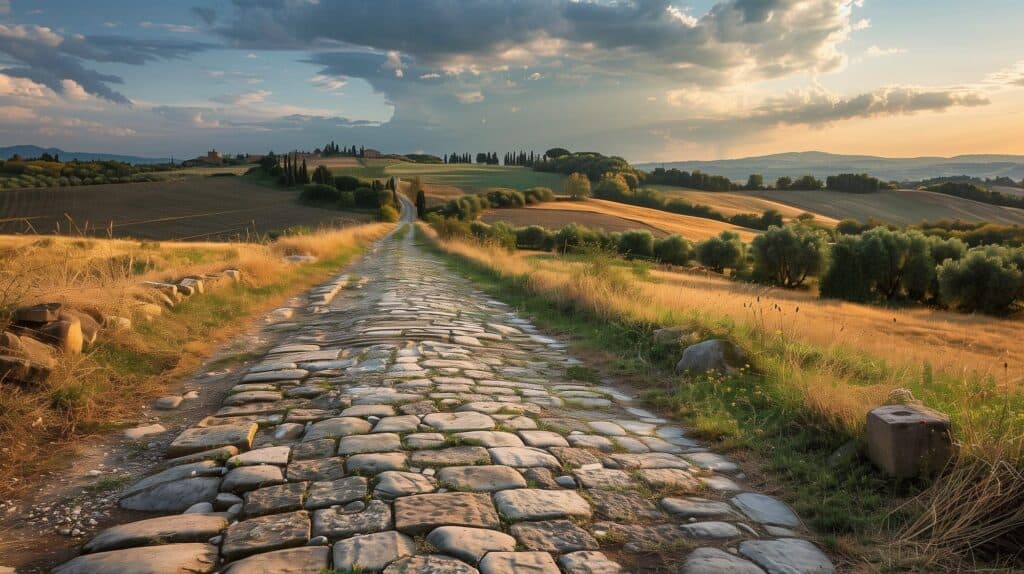
to enable the smooth and efficient movement of people, goods, and armies across the Empire. Built with a meticulous layering technique, these roads often began with a base of large stones for stability, topped with layers of smaller stones, gravel, sand, and finally tightly-fitted stone slabs. This layered structure provided excellent drainage, preventing water from pooling and ensuring the road surface remained intact even in harsh weather conditions.
The Roman road network was extensive, covering nearly 250,000 miles and linking Rome to all corners of the Empire. The famous phrase “All roads lead to Rome” reflects this well-planned connectivity, as the capital was the heart of a network that spanned from Britain in the northwest to the Middle East in the east. This connectivity was crucial for the Empire’s expansion and control, allowing troops to be deployed swiftly to remote regions and enabling the efficient transport of goods, which stimulated trade and economic prosperity. Cultural exchange also flourished along these roads, with ideas, customs, and innovations spreading throughout the Empire, leaving a unified yet diverse Roman cultural footprint.
Hidden Gem: Roman roads often included milestone markers that not only indicated distance but also provided travelers with information about the next stop, showcasing the Romans’ attention to detail in travel and logistics.
Why It’s Ingenious: The sophisticated construction of roads, which included drainage systems to prevent flooding, demonstrated an advanced understanding of civil engineering. These roads were so well built that many are still in use today.
Join an Etuk tour to walk along these ancient pathways and discover the history they carry. Experience the connectivity of the Roman Empire through its roads!
5. The Hypocaust System: Central Heating
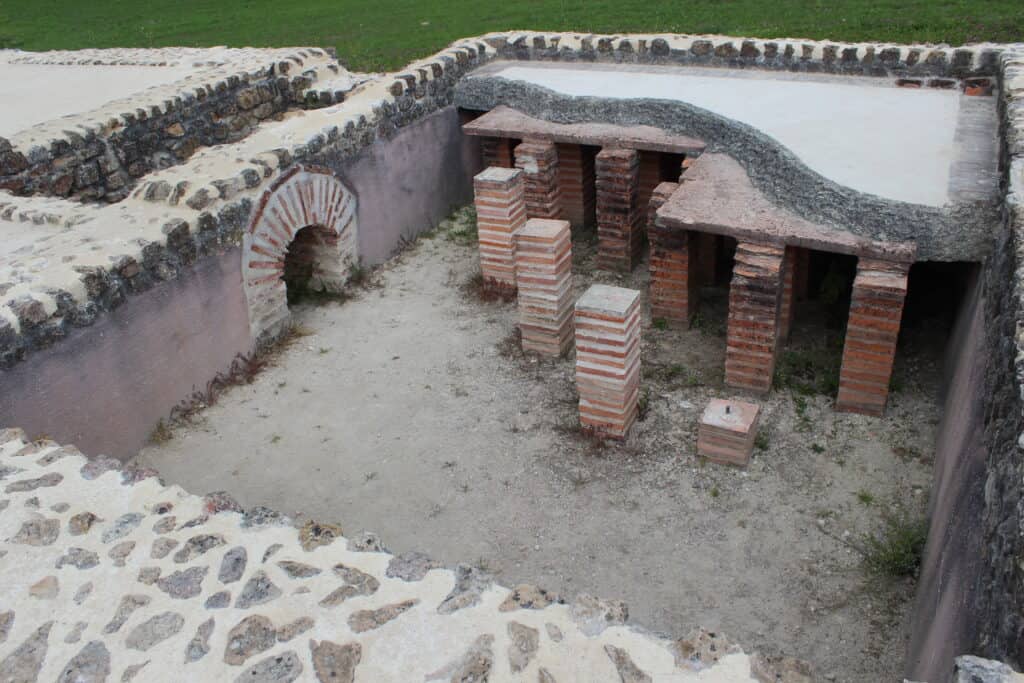
To keep their public baths warm and comfortable, the Romans developed the hypocaust system, an ingenious form of early central heating that demonstrated their deep understanding of thermal engineering. The hypocaust worked by channeling hot air from a furnace through a network of spaces beneath the floors and hollow walls, providing radiant warmth to the rooms above. This design allowed the heated air to rise and circulate, warming the floors and creating a gentle, evenly distributed heat throughout the bathing areas.
The hypocaust system was particularly essential in the caldarium (hot bath) and tepidarium (warm bath), where high temperatures were required. Roman engineers achieved this by constructing the floors on raised pillars called pilae stacks, creating an underfloor chamber for the hot air to flow through. Small flues built into the walls acted as chimneys, allowing hot air and smoke to escape while continuing to warm the space.
This system was not only a feat of engineering but also a symbol of Rome’s commitment to public comfort and health. Hypocausts were eventually used in wealthy Roman homes, villas, and public buildings, illustrating how advanced Roman society was in creating and managing indoor climate. The principles behind the hypocaust would influence later heating systems in Europe and around the world, underscoring the Romans’ lasting impact on building technology and comfort.
Hidden Gem: Some wealthy Romans even had hypocaust systems in their homes, allowing for comfortable living spaces during the cold months. The remnants of these systems can still be found in archaeological sites across Rome.
Why It’s Ingenious: The hypocaust system not only ensured warmth in the luxurious bathhouses but also highlighted the Romans’ innovative approach to comfort and hygiene. It represents a significant advancement in indoor climate control long before modern heating systems were developed.
Explore these luxurious spaces with us and experience the sophistication of Roman leisure on our tours. Feel the warmth of Roman innovation!
6. The Colosseum: A Masterpiece of Engineering
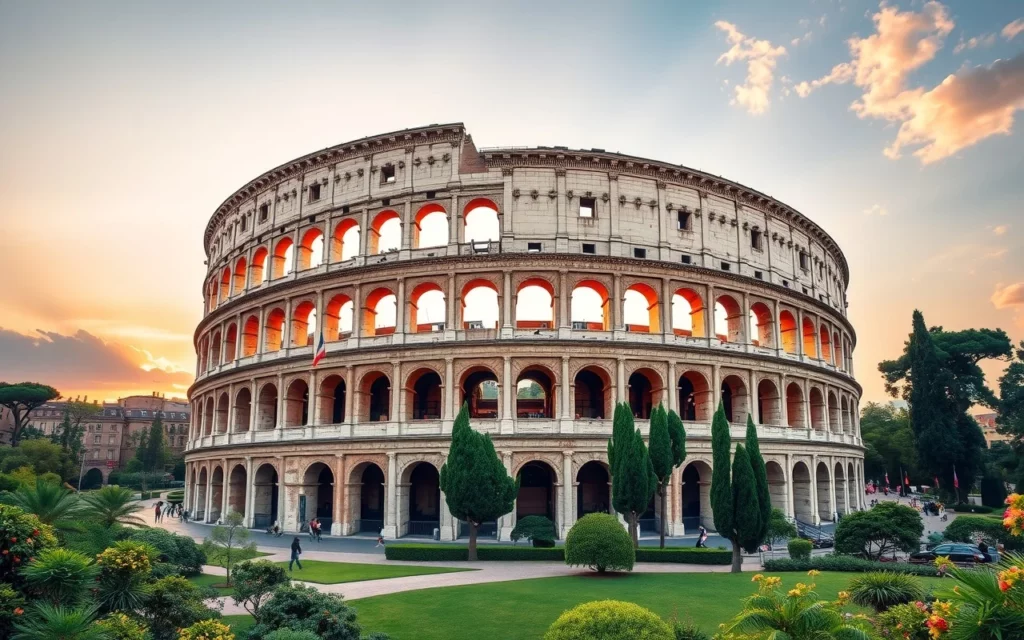
The Colosseum stands as a towering symbol of Roman engineering prowess and architectural innovation. Completed in 80 AD under Emperor Vespasian and his son Titus, this massive amphitheater—also known as the Flavian Amphitheater—could accommodate an estimated 50,000 to 80,000 spectators, making it the largest of its kind in ancient Rome. Designed to host gladiatorial contests, animal hunts, and public spectacles, the Colosseum represented both Rome’s grandeur and its ability to entertain on an unparalleled scale.
The Colosseum’s structural integrity relied on a sophisticated system of arches and vaults, which distributed its immense weight evenly and allowed it to reach impressive heights without sacrificing stability. These arches were not only functional but also added to the Colosseum’s aesthetic, creating a graceful yet powerful facade. Made from travertine stone and Roman concrete, the Colosseum’s construction materials and design exemplified Rome’s mastery of durable, high-capacity building techniques.
A marvel of logistical planning, the Colosseum was equipped with 80 entrances and an organized seating arrangement based on social hierarchy, allowing for the efficient flow of large crowds. Beneath the arena, a labyrinth of tunnels and holding pens known as the hypogeum housed animals and slaves, who could be raised into the arena via a system of pulleys and trapdoors—a dramatic feature that added an element of surprise for spectators.
Even after centuries of wear, natural disasters, and stone repurposing, the Colosseum remains an enduring testament to Roman engineering brilliance. Its influence is evident in modern sports stadiums, which continue to use similar principles of design and crowd management, illustrating the lasting legacy of Roman architecture and public entertainment.
Hidden Gem: The Colosseum also had a retractable awning system, known as the velarium, which provided shade for spectators. Sailors from the Roman navy were tasked with operating this massive covering, showcasing another aspect of Roman ingenuity.
Why It’s Ingenious: The design of the Colosseum allowed for efficient crowd control, with multiple entrances and exits that facilitated quick access and egress. Its sophisticated engineering has influenced amphitheater designs throughout history and remains a testament to Roman architectural prowess.
Discover the secrets of its construction on an Etuk tour and feel the history beneath your feet. Experience the grandeur of the Colosseum firsthand!
7. Baths of Caracalla: Advanced Plumbing

he Baths of Caracalla were a triumph of Roman engineering, showcasing sophisticated plumbing and architectural design on a grand scale. Built between 212 and 216 AD under Emperor Caracalla, this immense bath complex could host over 1,600 bathers at a time, covering around 27 acres and featuring pools, saunas, gymnasiums, libraries, and gardens. The baths exemplified Rome’s commitment to public health, recreation, and community, making them a vital part of daily Roman life.
One of the most remarkable aspects of the Baths of Caracalla was their advanced plumbing system. Roman engineers harnessed aqueducts to deliver fresh water directly to the baths, while a network of lead and clay pipes ensured a continuous supply to the various pools and fountains. Hot and cold water were regulated separately and channeled into different sections of the complex to maintain precise temperatures. Beneath the floors ran a complex series of tunnels and furnaces known as hypocausts, which provided radiant heating to the floors and walls, warming the rooms above and creating steam for the saunas.
Hidden Gem: The baths included cold, warm, and hot rooms, known as frigidarium, tepidarium, and caldarium, respectively. The careful design ensured that water was constantly renewed, providing a hygienic environment for bathers.
Why It’s Ingenious: The engineering behind the Baths of Caracalla reflects the Romans’ understanding of water management and public hygiene. These baths were a social hub, emphasizing the importance of cleanliness and leisure in Roman culture.
Experience this grandeur firsthand by visiting the baths on our exclusive tour. Dive into the luxury of Roman wellness and hygiene!
8. The Pantheon: A Dome to Remember

The Pantheon in Rome stands as a true marvel of ancient engineering and architectural design. Built during Emperor Hadrian’s reign around 126 AD, it boasts the world’s largest unreinforced concrete dome—a testament to Roman ingenuity. The Pantheon’s dome, which spans 142 feet in diameter, is crowned by an oculus, a central opening that bathes the interior with natural light, creating a breathtaking visual effect as the sunlight shifts throughout the day. This oculus also lightens the dome’s weight and relieves stress on the structure.
The Romans showed remarkable understanding of materials science in the construction of the Pantheon. They utilized heavier materials, such as travertine, at the dome’s base to ensure stability, and transitioned to lighter materials like pumice near the top. This strategic layering reduced the overall weight of the dome, allowing it to achieve its unprecedented span without collapsing.
Beyond its technical brilliance, the Pantheon’s design holds symbolic meaning. The building’s perfect symmetry and proportions reflect Roman ideals of harmony and balance, with the dome symbolizing the heavens. Nearly two millennia later, the Pantheon still stands intact, a stunning reminder of the Romans’ expertise in engineering and architectural aesthetics, inspiring modern structures around the world.
Hidden Gem: The oculus at the top of the dome serves as both a structural element and a source of natural light, creating a breathtaking effect as the sunlight shifts throughout the day.
Why It’s Ingenious: The Pantheon’s dome is a testament to the Romans’ mastery of engineering and architectural design. Its innovative use of concrete and strategic weight distribution continues to inspire architects and engineers around the world.
Standing beneath this dome is a must for any visitor—join us for a tour to witness this engineering marvel and gain insights into its design. Experience the awe of the Pantheon!
9. Military Engineering: The Roman Fortress
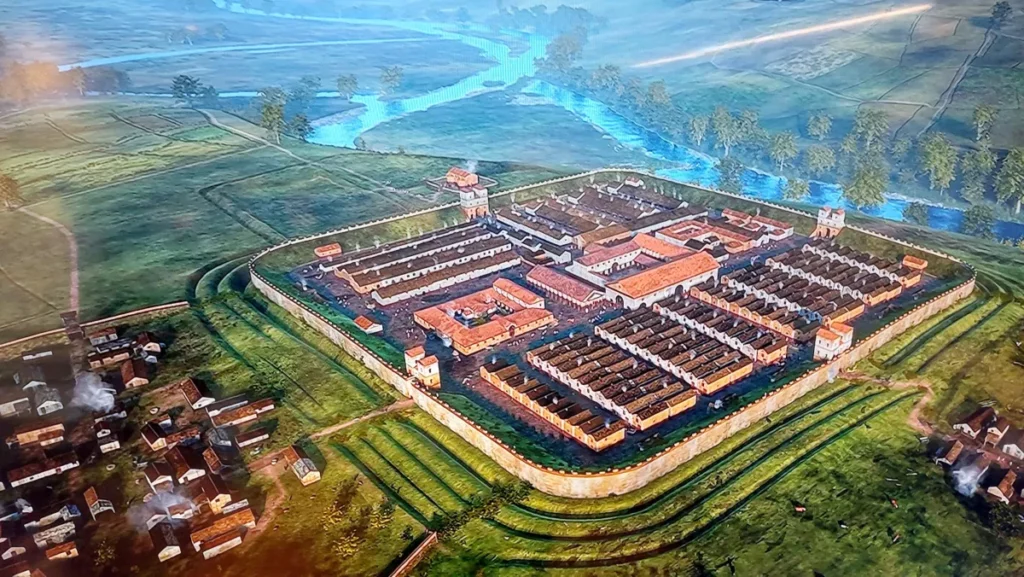
The Romans were masters of military engineering, designing fortifications and military camps with precision and strategic foresight. Their camps, known as castra, were systematically laid out to maximize efficiency and defense, often resembling miniature cities with well-planned roads, barracks, defensive walls, and designated areas for training. Each camp was designed with a consistent layout, allowing soldiers to quickly navigate and defend their positions in unfamiliar territories.
These camps were often surrounded by deep ditches, ramparts, and palisades to deter enemy forces and provide a secure perimeter. Inside, Roman engineers established roads in a grid pattern, linking key sections of the camp such as the commander’s quarters, storage areas, and the main training grounds. The camp layout also included watchtowers and lookout posts, which provided a vantage point for monitoring surrounding areas.
By creating fortified, organized, and self-sustaining camps, Roman legions could establish control over conquered territories swiftly, regroup efficiently, and respond to threats effectively. This disciplined approach to military engineering was one of the secrets to Rome’s military success, enabling the Empire to expand and maintain its vast borders across Europe, North Africa, and the Middle East. Today, the remains of these fortifications offer a glimpse into the remarkable skills and organization that characterized the Roman military machine.
Hidden Gem: The Roman military camps often included sophisticated drainage systems and barracks designed for optimal soldier comfort and efficiency, demonstrating an understanding of both military and civil engineering.
Why It’s Ingenious: These fortifications allowed the Romans to maintain control over their vast empire, providing security and enabling quick deployment of troops. The principles of military engineering used by the Romans laid the foundation for modern military fortifications.
Explore the remnants of these military sites on an Etuk tour and learn about the strategies that expanded the empire. Discover the strength of Roman military ingenuity!
10. The Via Appia: The Queen of Roads
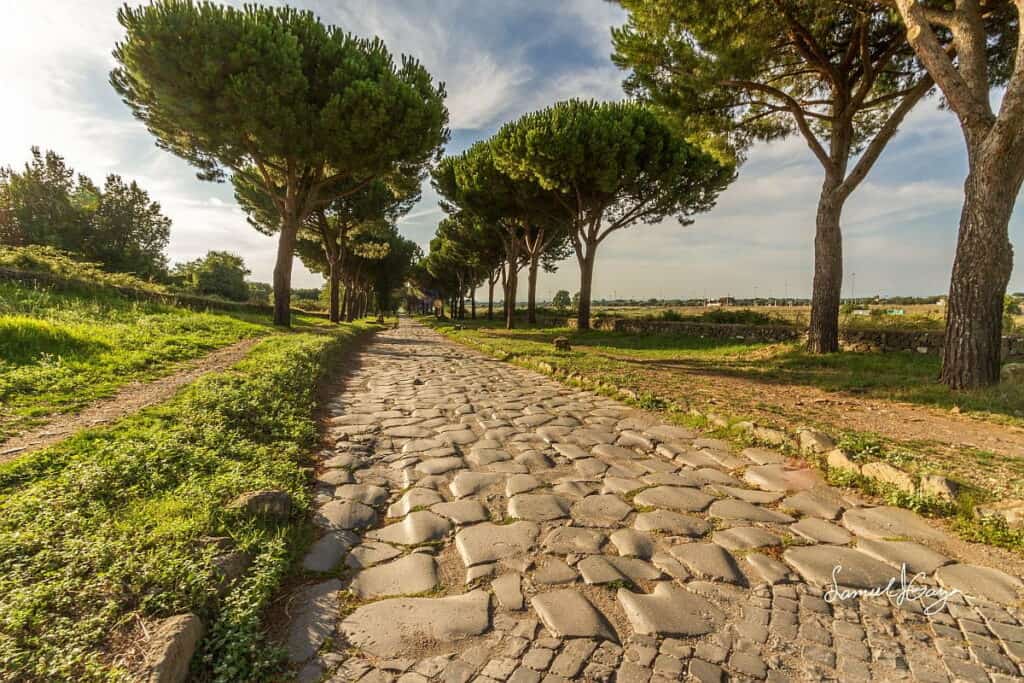
The Via Appia, famously known as the “Queen of Roads” (Regina Viarum), is one of the most renowned Streets in Italy Rome and a testament to ancient Roman engineering. Built in 312 BC by the Roman censor Appius Claudius Caecus, the Via Appia was originally designed for military and economic advantage. Stretching from Rome to the southeastern port city of Brundisium (modern-day Brindisi), this impressive roadway connected the capital to Italy’s southern regions, allowing for the swift movement of troops, resources, and trade goods throughout the Republic and later the Empire.
As one of the ancient streets in Italy Rome, the Via Appia became much more than just a road; it transformed into a corridor of history, lined with tombs, villas, and monuments that showcased Rome’s grandeur and cultural legacy. Today, visitors walking along the Via Appia can explore these historical sites, making it feel like an open-air museum that highlights Rome’s architectural and engineering achievements.
For anyone intrigued by historic streets in Italy Rome, the Via Appia offers a unique journey through time, providing an unforgettable perspective on the past glories and lasting influence of the Roman Empire.
The road’s construction was groundbreaking, designed with multiple layers for durability. Engineers used a base of large stones to support the roadbed, topped with gravel, sand, and tightly fitted stone slabs that allowed for smooth travel. This sophisticated design not only made the road sturdy and resistant to weather but also capable of handling the heavy traffic of carts, horses, and foot soldiers over centuries.
The Via Appia also played a significant cultural role. It was lined with tombs, monuments, and family mausoleums, as burial along major roads was a Roman tradition for the elite. This made the Via Appia a symbolic passage for both the living and the dead, blending infrastructure with cultural reverence. Even today, sections of the Via Appia remain, offering a testament to Roman engineering expertise and the Empire’s long-lasting impact on road construction, infrastructure planning, and cross-regional connectivity.
Walking along the Via Appia is a journey through history, where one can still feel the echoes of ancient Rome’s power, innovation, and resilience.
Hidden Gem: Along the Via Appia, travelers could find burial sites and monuments, as it was a major route for funerals, highlighting the Romans’ connection between their infrastructure and cultural practices.
Why It’s Ingenious: The construction of the Via Appia included carefully chosen materials and techniques that ensured its durability, making it an enduring symbol of Roman engineering. Its straight routes and solid foundations exemplify the efficiency and foresight of Roman planning.
Walk a stretch of this historic road on our tours and appreciate its significance in Roman history. Feel the legacy of the Romans beneath your feet!
Final Thoughts
The ingenuity of Roman engineering continues to inspire and fascinate. Their techniques not only built the foundations of modern architecture but also demonstrated a remarkable understanding of materials and design. When you’re in Rome, don’t miss the chance to explore these historical marvels. Book your Etuk tour today and dive deep into the legacy of Roman engineering that shaped the world.



